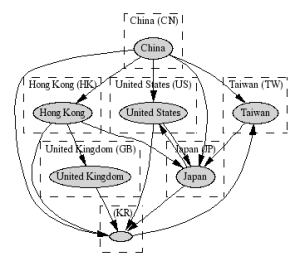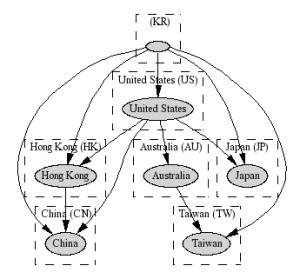...
We have at least one monitoring node in South Korea, Japan, China and Taiwan. With the help of those, we gathered the traceroute results for the neighbours as well as the world as shown in the figures below.
|
|
| |
Routes to neighbours | Routes to neighbours | Routes to neighbours | Routes to neighbours |
|---|
The traceroute results (annotated, raw) originating from China show that China is directly connected to its neighbours i.e. Taiwan (#5, 61 ms), South Korea (#27, 73 ms) and Japan (#8, 100 ms) and the traffic generally takes the direct routes. However in some cases, the results show that traffic destined for South Korea is either routed via Japan (#7, 114 ms) or Japan and US (#16, 209 ms) or Hong Kong and United Kingdom (#54). Similarly in some cases, the traffic destined for Japan is is routed via via Hong Kong (#24, 206 ms) or Taiwan (#25, 90 >90 ms). Strangely enough Also, traffic to Taiwan is sometimes directed via South Korea (#27, 245 ms). On the other hand when the destination is within China, the traffic stays within China which is what one would expect.
The results (annotated, raw) from South Korea show that Korea is directly connected to Japan (#1, 36 ms), Taiwan (#6, 214 ms), China (#11, 110 ms) and the US and the traffic generally takes the direct routes. However other some results show that traffic destined for Japan is directed via the US (#23, 182 ms). Similarly, traffic destined for Taiwan is sometimes routed via the US and Australia (#2, 272 >272 ms) . Also and the traffic destined for China is sometimes routed via Hong Kong (#80, 97 ms).
The trace routes from South Korea to its neighbours show interesting results. Despite the fact that countries such as Vietnam, Philippines, Singapore, Thailand are in the vicinity, the traffic flows via United States, Germany and Canada unlike the case of Japan or China where the traffic mostly flows via Hong Kong.
Korea to Korea: Direct
Korea to China: Korea -> United States->Hong Kong OR Korea -> China
Korea to Thailand: Korea ->United States (Colorado -> Canada (Quebec) ->Thailand
Korea to Singapore: Korea -> United States(Colorado) -> Singapore
Korea to Japan: Korea -> Japan
Korea to Philippines: Korea -> Germany->Hong Kong->Philippines
Korea to Vietnam: Korea -> United Kingdom-> Hong Kong -> Vietnam
Lastly the traffic destined within Korea is observed to stay within Korea as one would expect.
The traceroute results (annotated, raw) originating from Taiwan show that Taiwan is directly connected to its neighbours Japan (#1, 34 ms), China (#17, 61 ms), Korea (#7, 45ms), Hong Kong (#63, >30 ms) as well as the United States and the traffic generally takes the direct routes. However in some cases the results show that traffic destined for Japan is routed via the US (#23, >140ms) or Hong Kong (#74, 73ms). Also, the traffic destined for South Korea is sometimes routed via Japan (#18, >65 ms). As one would expect, the traffic destined for a node within Taiwan stays within Taiwan.
Interestingly though, Japan is directly connected to its neighbours and nearly all the traffic to destinations in neighbouring countries is routed via the direct links. Taiwan to China: Taiwan -> China
Taiwan to Korea: Taiwan -> United States -> Japan -> Korea
Comparison with Human Development Indices
...



